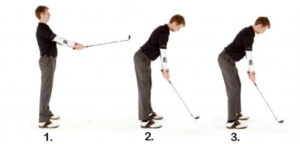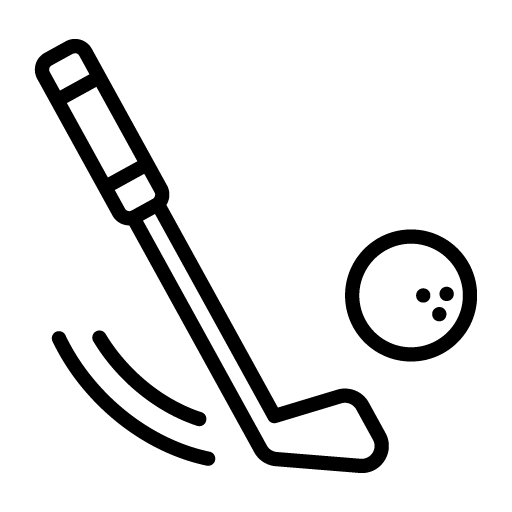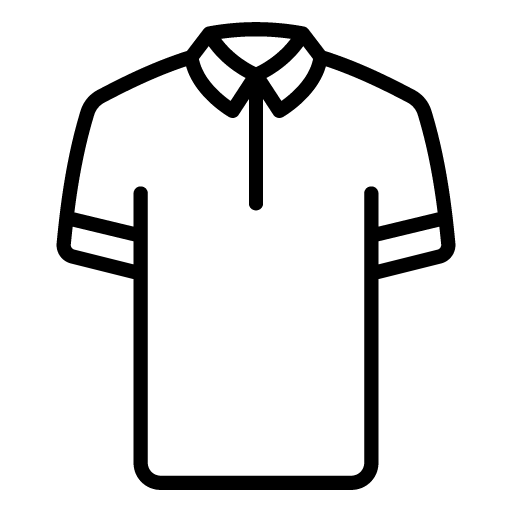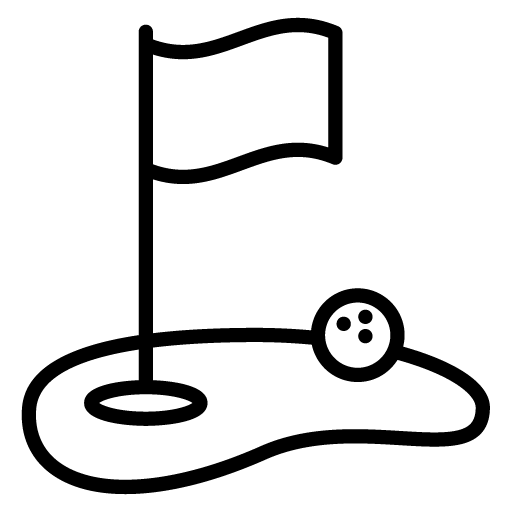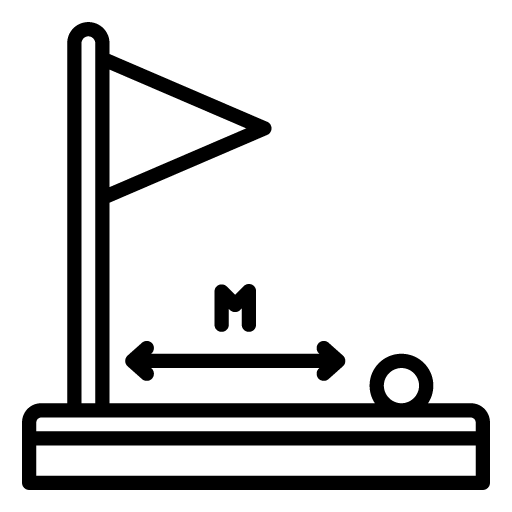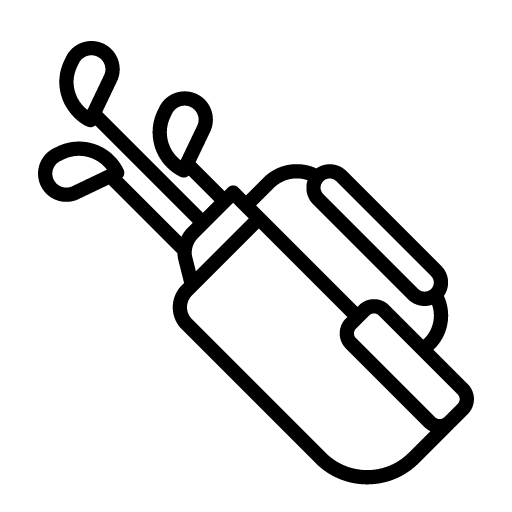Any good golf coach will address posture before anything else. Before grip and definitely before the correct clubs and shafts for your swing speed. Before anything. There is no way you can have the proper take away if your posture and setup is incorrect. So, let’s go over the setup and posture in great detail.
One of the things I see most at driving ranges around the country is strong, athletic men with a very wide stance at setup. The reason for this is strong guys think wide is strong. If you were to get into a fight, you wouldn’t stand with a narrow stance, right? Remember, the golf swing is different than being in a fight. The golf swing is rotating one’s upper body around their lower body. One of the main issues with a very wide stance is the fact that posture often breaks down because the feet are not under the hips. So, the proper setup and posture is as follows:
Your feet should be directly under your hips. You may want to practice hitting balls with a very narrow stance with your feet “inside” your hips to break the habit of a super wide stance just to get the feel. There are dozens of golf drills with your feet together or a very narrow stance. Basically, they are all trying to get you to make certain your hips are over your feet and knees and not inside your feet and knees. If your hips are inside your feet and knees, meaning you have a very wide stance, you are not going to be able to turn to the top of the backswing. You will be very restricted when you get halfway through the backswing. This is why almost every amateur on a golf course stands up during their backswing and has to “bob” down during the downswing. You see this everywhere. The guys who look like they are bobbing for apples.
Polishing: To really feel the weight and strength on the balls of your feet, try “digging in” with the balls of your feet as you set up. Think about a baseball player digging in his cleats in the batters box. When you dig in your heels will be just slightly off the ground and your calves will be slightly flexed. You should feel that you are gripping the ground with the balls of your feet.
With your feet under your hips, you should feel almost as if you are “falling over” at the chest and shoulders. There are numerous photos showing golfers holding the club straight out in front of them before bending over to put the club on the ground. Here is an example:
From position #1 to position #2, you will tilt at the waist with only your hips. You should feel your hips over your knees or a little bit behind them. When you feel this you are likely going to feel like you are falling forward because you haven’t felt the weight of your chest and shoulders over your hands at setup. This is especially true if you have been on your heels with your past setup.
Many amateur golfers end up with most of their weight on their heels because they see professionals keeping their entire foot on the ground throughout the swing. They try to emulate this and the easiest way to keep the heel on the ground is to put all the weight on the heels. The weight should be on the balls of your feet. In fact, the weight on your toes would be better than the weight on your heels.
As you are going through your setup, it is very important to make certain your hips roll forward and your lower back is flat and not rounded. This is a problem I have had while learning a new golf swing. Any time I learn new information about the backswing or downswing I stop thinking about my setup and my hips do not tilt forward in the proper manner. When you start working on a beautiful backswing, you are going to need your hips to be tilted forward and your butt is going to feel like it is sticking out a little bit.
Polishing: You will likely feel your calves stretch and your hamstrings engage when you are properly titled over the ball. If you go to the range and hit balls or practice your setup a few dozen times, you may very well start to feel a little bit of soreness in your calves. This is a good thing.
It is very important to note that sticking your butt out is not the same thing as tilting or rolling your hips forward. You can very easily stick your butt out with the majority of your weight on your heels and your hips rolled back and behind the knees.
The knees will be very slightly bent when you properly roll or tilt your hips forward. If you have had a super athletic stance with bent knees in the past, you may want to think about keep your legs completely straight as you lower the club to the ground. Most super athletic people are going to naturally bend their knees so it may feel as if your knees are straight but they are actually going to bend slightly.
Polishing: Before you lower the club by bending at the waist, with the hips, you may want to consider engaging of flexing the outside of your quads. This will feel like you have a medicine ball between your legs and you are squeezing it with your inner quads. You see this drill a lot on the Golf Channel and ranges around the United States. What you are doing is stabilizing your lower body so you don’t sway and get loose on the backswing.
Once you have your feet, knees and hips in the proper position you will need to make certain that you are standing “tall”. You want your chest and shoulders to be high in your setup. This too can be difficult for anyone that has slouched or put their weight on their heels in their previous setup. A high chest and shoulders is 100% necessary for the proper takeaway and to get the backswing moving toward the top.
Note that it is a “high” chest and by standing tall, I do not mean the chest as far away from the feet as possible. You want your chest “high” compared to your midsection or belly button. Remember, we are staying bent over at the hips. Your friends and golfing buddies likely will not think you have a “tall” setup but you will know that your upper body is long and they will have no idea what you are talking about.
In the past, I have noticed that I “lose” my backswing every now and again. The feeling just isn’t there. After some analysis, I quickly realize my posture and setup is defective. Most of the time, I am not tilting my hips forward and my chest and shoulders are not high as I set up to the ball. If you feel as if your backswing has disappeared or you are struggling to get the club to the top of the backswing, you may want to look at your setup and posture. This is a quick fix if you have the roots of a good swing.
So, how long should you work on setup and posture when learning a new swing? When I was learning a new swing with a professional swing coach that has players on the PGA Tour I was asked to work on setup and posture for a full week. I was to hit balls as much as I’d like, 30 at a time before several hours of rest, but the main focus was on setup and posture. During that week, it truly felt like I was going to fall forward as I took the club back. Note that you will always be working on polishing your setup and posture. Even when you get to scratch or better.
Polishing: Later on in my swing transformation my coach told me that he always spends the first four (4) lessons on posture and setup. This is a professional swing coach that has worked with PGA Tour winners. You are not going to get four (4) lessons of setup and posture at GolfTEC or some of these other places; even your local country club pro will only touch on it briefly.
To me, it looked like the heel of the club was on the ground and the toe of the club was up in the air. This was overcompensating from my previous swing but it helped me to realize where my weight should be (on the balls of my feet) and the amount that I should be tilted forward. I don’t use the phrase bent over because you shouldn’t feel bent over in the golf swing. You should feel tilted forward.
Now that we have your lower body and chest and shoulders in the correct posture, where do the arms come into play? Note that we are talking about the arms and hands last. This is because the golf swing should not be about the arms and hands. They are just levers that rotate around the body. They do not create speed nor do they flip or rotate the club at impact. Your body will do that. So, with that being said…
It is a good practice to tilt your right shoulder back (for a right handed golfer) and allow your arms to tilt with it. Anywhere between 15 and 20 degree is fine. This shoulder tilt will start you out in the correct position. Something I do with every swing is to look at the club face to make certain it is square then I look at the shaft to make certain it is tilted back about 15 degrees which is the same as my shoulders.
I then take all the pressure of my grip off the club. The only pressure I feel is my left index finder and my right pinky that are overlapped. This pressure is very, very soft. As I lower the club down behind the ball, I make 100% certain my hands and arms are not tense. I do not want my hands, arms or shoulders to do anything in the swing so I want to make certain they are not activated at impact.
Polishing: As you advance, you will be able to hinge the left wrist before you lower the club without flexing your arms. During the first 60 to 75 lessons, you are likely to continue to flex your arms any time you hinge your left wrist. Once you can soften your arms, the hinge will be created through the grip or handle of the club.
I completely avoid any type of waggle or hitch as this is sending a trigger to the brain that the hands want to “play”. The hands do not get to play in the golf swing. They can play in other areas of life but not the golf swing.
With the club behind the ball, I make certain my hips are tilted forward, my knees are very so slightly bent, the outside of my quads are engaged to keep me inside, my chest and shoulders are high and my arms and hands are very relaxed. Before takeaway, I make my chest even taller and let my hands dangle loosely. I want to feel as if my hands are barely on the grip of the club when I start the take away. I also feel my lower lats supporting my chest and shoulders. Over time, you will start to feel the middle of your back, or the lower lats, much more than the shoulders and upper back.
It is very important to understand that the hardest part of the golf swing is to take away the hands, arms and shoulders. Every single time I go to the driving range I see someone start their backswing with a hitch or their hands are the trigger. In fact, about 80%, or more, of amateurs start the backswing with their hands. If you do this, you are never going to have a consistent golf swing nor are you going to be able to have a consistent shot shape. You may draw or fade the ball but the amount of draw and fade will be different every time.
Handsy swings also cannot adjust trajectory. You will likely notice that most of your friends or playing competitors that hit the ball far cannot change their trajectory. In fact, I would imagine most of your friends that hit it far hit it relatively low. This is because they are de-lofting the club. Basically, they are turning an 8 iron into a 6 iron. If you ask them to hit a high, three yard draw with a 9 iron, they cannot do it.
A great golfer can change trajectories and can definitely hit the ball high. My swing coach does not want me to hit my pitching wedge with a full swing because the ball will go too high and it will spin too much. Those guys that hit the ball a long way with a hooded or de-lofted club also cannot spin the ball. If you hit the ball correctly, you will spin it back even on the fairway. Ask one of your buddies that thinks he is a scratch to hit an 8 iron as a lay up shot on a par 5 and see if it spins back on the fairway. If not, he is using his hands and flipping at impact to get power. In a stressful environment, he will break down.
The first step to beating your buddies and becoming a better golfer is to clean up your posture and setup. When you set up and create the better posture, make certain your hands, arms and shoulders are out of the swing. Now, on to the take away.
When watching PGA Tour players, take note of how “bent over” they look. Rory McIlory plays significantly better when he is “bending over” more. Dustin Johnson and Keegan Bradley are bombing their drives when they are bent over at the hips. When they start to get loose and are not playing well, it often comes back to the fact that they are lazy at setup and their posture breaks down.

